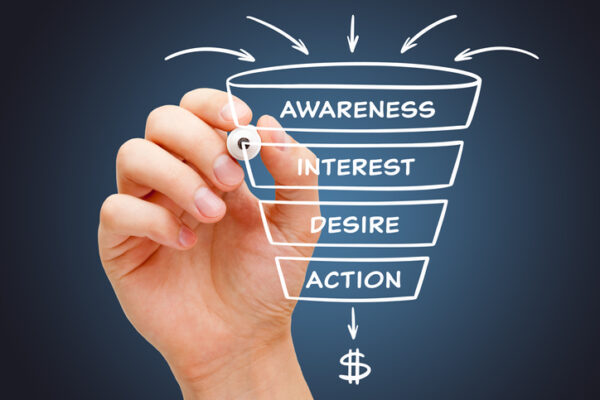Contributor: Christian Kligora, SVP Customer Success/Marketron
The buying funnel, I’ll admit, is a jargony type of term. It’s one that many of your advertisers may have sparse knowledge of. What they do know is that they need to get in front of the right audiences at the right time. Even those with awareness realize the funnel is complicated and no longer linear. Many things impact when and how people make purchases from businesses.
As a trusted marketing professional to your clients, they depend on you to provide some education on the funnel and explain the importance of addressing every step to engage, attract and convert customers.
The Funnel Basics: How to Talk to Advertisers About Tactics and Alignment
The first step in informing advertisers and getting them on board with full-funnel advertising is going over the basics. You’ll want to advise them on how customers research and think and which tactics align with each phase.
Here are some ways to explain it in easy-to-understand terminology.
Awareness
At the top of the funnel is awareness. The consumer knows they have a problem and is in a research mode. They are in the planning stages and want tips, education and information. While there’s no buying intent, it’s still a critical phase for advertisers to plant a seed. You can propose several tactics to connect with customers here:
- SEM (search engine marketing) campaigns that focus on “learning” and “exploring” keywords
- Brand awareness display ads with key messaging about the business
- Radio ads that introduce listeners to the company and what it does
Consideration
In the next stage of the buying funnel, customers have fully realized the scope of their problem and are studying the possible products or services to purchase. Advertisers want to stand out among the competition, so they need to lean on tactics that illustrate their reliability, quality and trustworthiness. Advertising options for consideration include:
- SEM campaigns that target competitor keywords that would lead to a webpage comparing themselves to their competitors
- Social media ads targeted to ideal customer demographics and location that include social proof points like star ratings, reviews, awards and testimonials
- OTT/CTV (over-the-top/connected TV) ads with demographic and location targeting that include comparison content (e.g., product 1 vs. product 2)
- Radio ad spots with unique language and promotions for new customers, with a special URL or code for attribution purposes
Decision
In the final stage, consumers are ready to buy. In some cases, when the need is urgent or well understood, a customer may start here. For example, a homeowner dealing with an emergency leak needs a plumber pronto. Regardless of how the consumer becomes ready to purchase, these tactics work:
- SEM campaigns that use buying language like purchase, hire, schedule, book, etc.
- Display ads with geofencing to entice nearby shoppers and drive foot traffic
- Social media ads with a limited-time promotion to push urgency
- Radio ads that highlight a one-day deal or event (For example, airing special family dinner promotions on Friday morning could increase orders on the night people are less likely to cook.)
These are just a few examples of how to position full-funnel advertising. No matter the customer base or type of business, their audience will align with these phases. When they build on the awareness and consideration phases, they have a greater chance of earning the conversion.
This approach also helps you showcase your value as marketing professionals to local advertisers and handle objections around campaign lengths and spend. Some of your clients may have misconceptions that an SEM campaign running for a few days will deliver results instantly. Others may think they only need promotional ads. When you can sketch out the whole buying cycle, they’ll have more realistic expectations, and you’ll be able to help them build their funnel.
Further, integrating digital and radio is a winning strategy. In fact, as studied by the RAB and others, radio lifts digital ad performance.
No Two Customer Journeys Are the Same, So How Do You Scale?
With such diversity in the customer journey, you may face challenges with scale across your sales efforts. To build full-funnel campaigns, as a marketing professional, you’ll need to look to technology for scale. Using a solution that enables radio and digital proposals, orders, invoicing and reports keeps everything cohesive and allows you to be more productive.
Adopting these cross-channel platforms is also helping radio stations improve third-party digital revenue. Advising your advertisers on the benefits of cross-channel platforms will help them understand how to maximize their advertising budgets and build more effective advertising campaigns.
If your team hasn’t transitioned to cross-channel advertising technology and workflows, now is the time to consider your options as you work toward hitting numbers in 2023 — a year that won’t see the political advertising boost broadcast is experiencing currently.
Filling the Funnel Is Good for All Parties
In your next client meeting, lay the groundwork to discuss full-funnel advertising. Present scenarios for them with specific tactics. You don’t have a crystal ball to ensure success, but you have a plan. Once they have an “Aha!” moment, they’ll realize the value of advertising at all phases. You’ll be able to plot a strategy for growth for today and tomorrow, not just a one-off campaign or a singular tactic.


